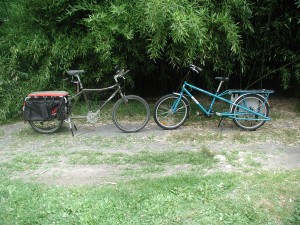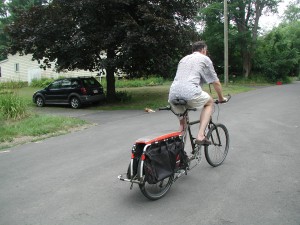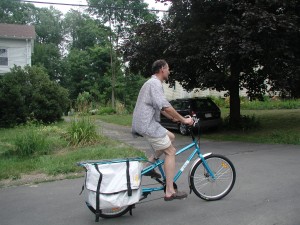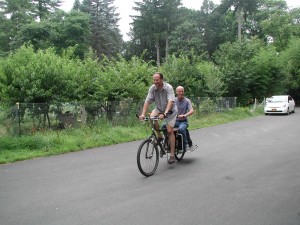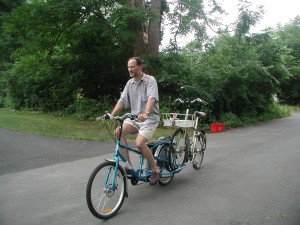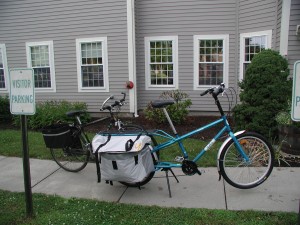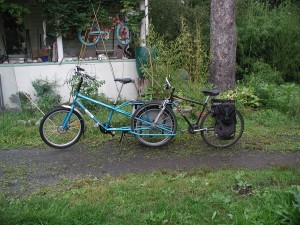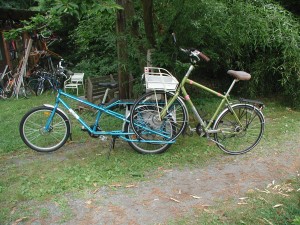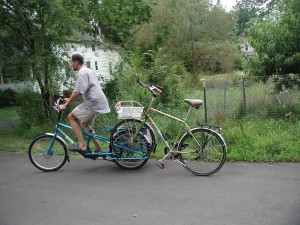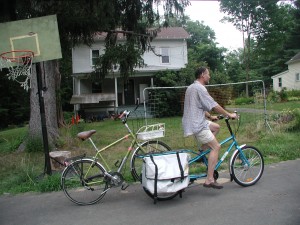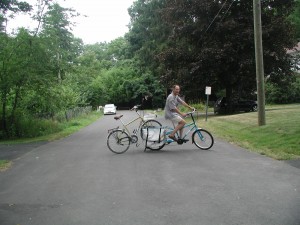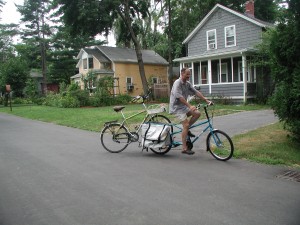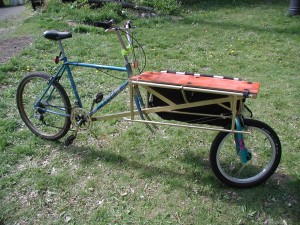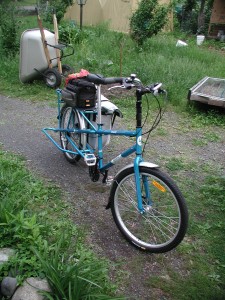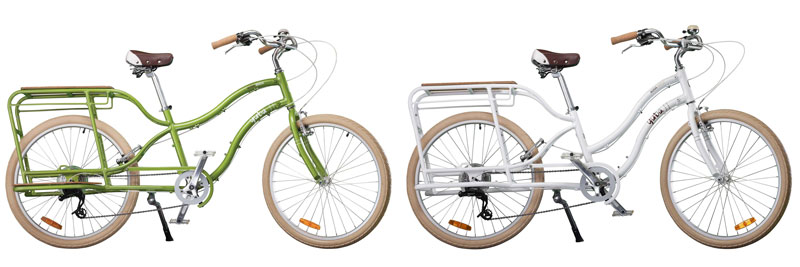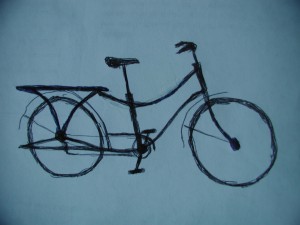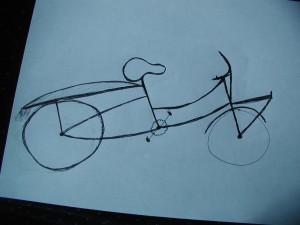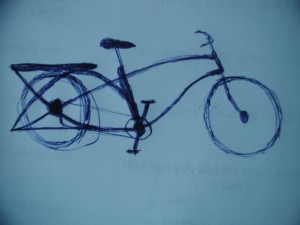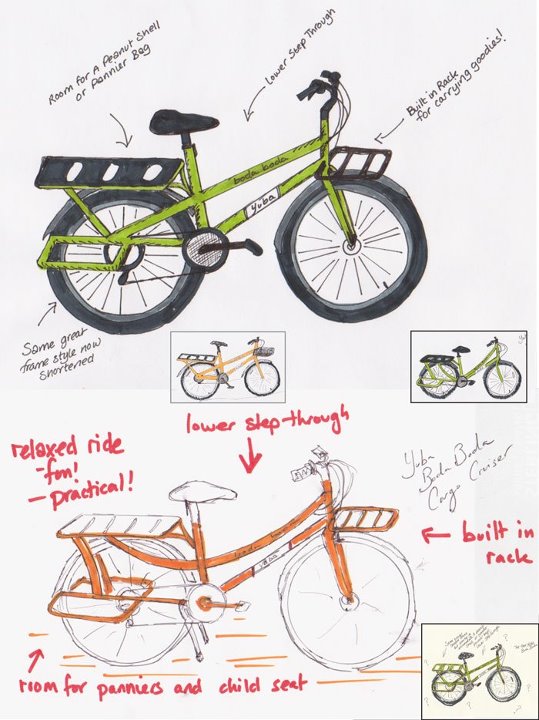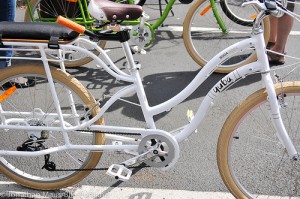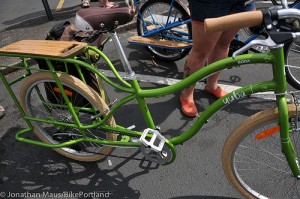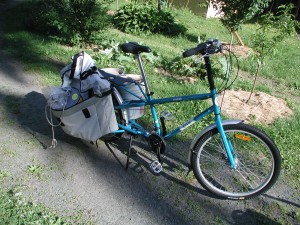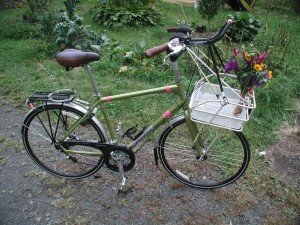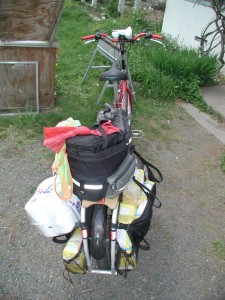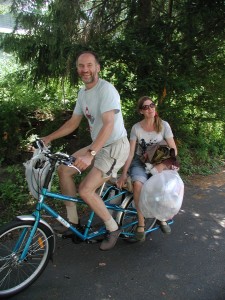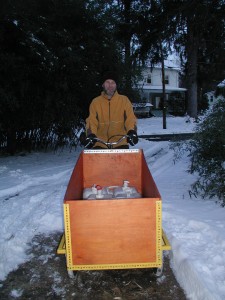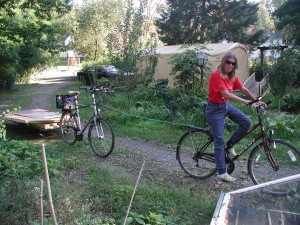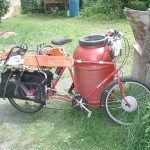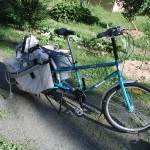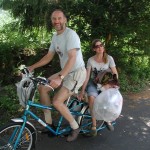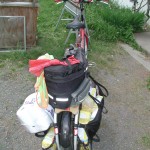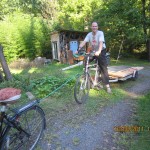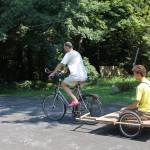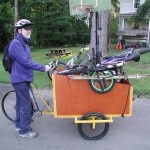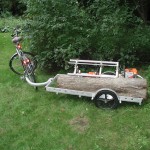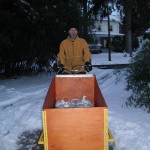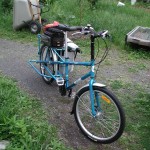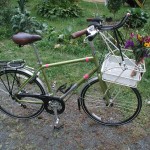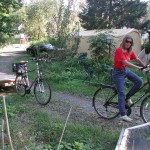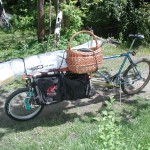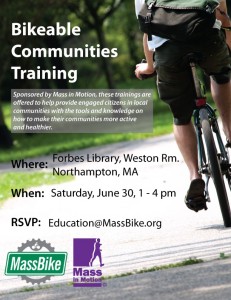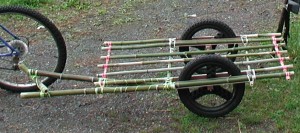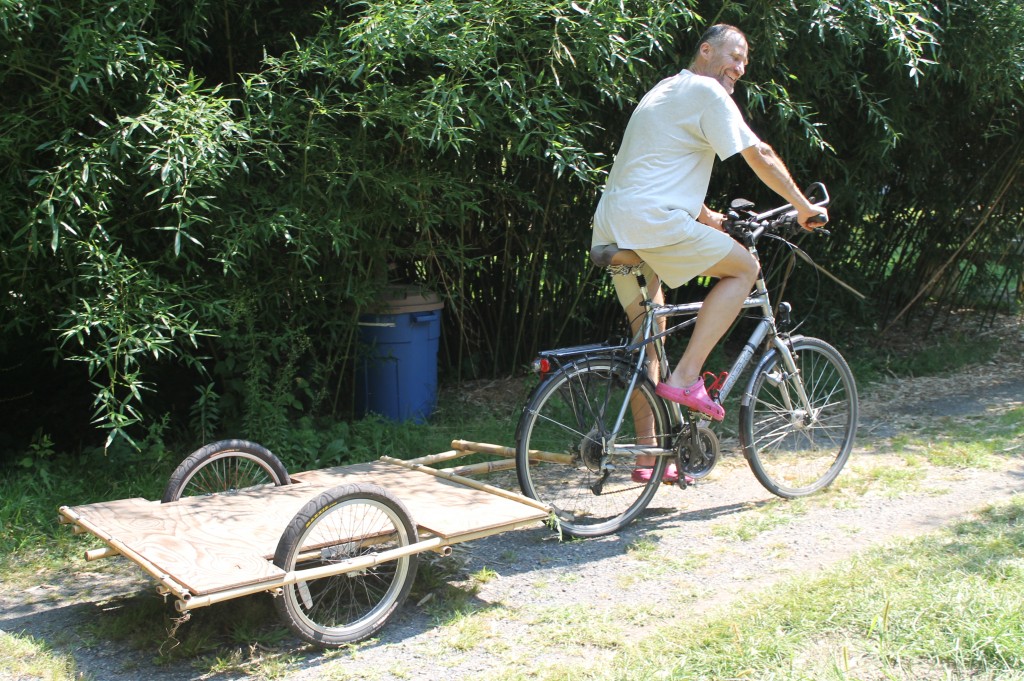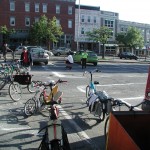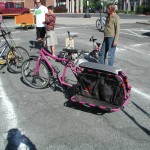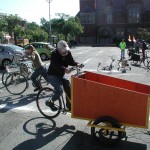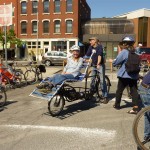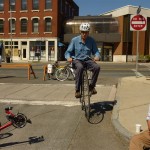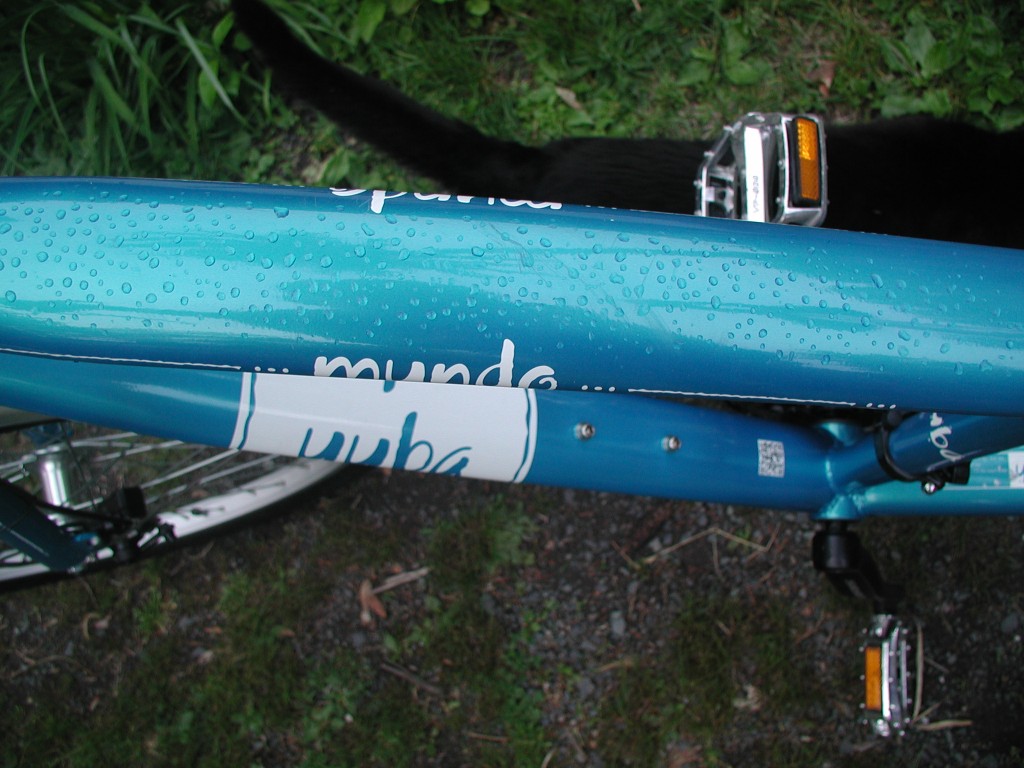It just so happened, that last weekend I needed to pick up chicken feed, and since I expect grain prices to increase soon due to the drought, I decided to get some extra. So I took the Mundo, and once at the store, I bought four fifty-pound bags to spur myself to figure out how to secure them all on the bike and haul them home.
Well, it wasn’t hard: one fit into each of the side panniers with quite a bit of room to spare, and the other two I put onto the top platform, side-by-side, again with some room to spare. I certainly felt the two hundred extra pounds, especially on the uphills, but the bike had plenty of gearing, so the hardest part was to balance the bike at other errand stops on the way home. Because of balancing only on two wheels, and having to put two bags up on the top platform, I had to really pay attention to which way the bike leaned. The standalone kickstand took care of the balance once it was set, but getting there required to lift part of the bike, and every part seemed to be quite heavy.
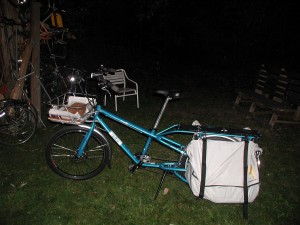 Encouraged by the apparent ease of riding the Mundo with heavy load, I decided on doing an errand, that I was thinking about for a while. The load was steel, so the volume remained small, but it sure turned out to be heavy. Unfortunately, since it was a secret operation, I must keep the nature of the load and the location of the source private – you can surmise parts of it from the pictures.
Encouraged by the apparent ease of riding the Mundo with heavy load, I decided on doing an errand, that I was thinking about for a while. The load was steel, so the volume remained small, but it sure turned out to be heavy. Unfortunately, since it was a secret operation, I must keep the nature of the load and the location of the source private – you can surmise parts of it from the pictures.
So Marianne and I got on our bikes on a quiet Sunday evening, timing our trip so that by the time we reached our destination, it would be dark. We even had to travel on a longer way, so we wouldn’t arrive too soon. But arrive we eventually did, and the cache was there, waiting – unfortunately out in the weather, so quite rusty, instead of the gleaming as treasure caches usually wait, no?… We expected the rustiness, however, so in the two go-getter bags I had a good pile of newspapers to help avoid my new bags getting dirty, and also to reduce the noise iron pieces would make when carried over uneven surfaces with a bike.
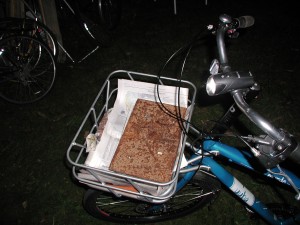 Once all loaded including the front mounted bread-basket, which I am rather impressed with, I grabbed the bike by the horns to get it off the two pointed wide kickstand, and … nothing happened. I had to lay my whole body into the effort before the bike budged and would move. Getting onto the road was also a workout as the path was dirt and slightly uphill. But I really got to experience the weigh, as balancing a lot of weight on two wheels can be challenging.
Once all loaded including the front mounted bread-basket, which I am rather impressed with, I grabbed the bike by the horns to get it off the two pointed wide kickstand, and … nothing happened. I had to lay my whole body into the effort before the bike budged and would move. Getting onto the road was also a workout as the path was dirt and slightly uphill. But I really got to experience the weigh, as balancing a lot of weight on two wheels can be challenging.
Once we were moving though, it all went smoothly. I mean the ride was bumpy all right towards home but only because of the bumpiness of the road surface, and the newspapers only worked somewhat – I guess the pieces were two heavy to be silenced by the New York Times from the neighbors recycling bin. However the whole ride went easier than I expected, and although there was a section of a steep uphill, I even had a low gear to spare – one which I ended up not having to use.
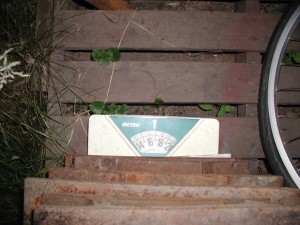 Once we arrived home, and I successfully put the bike on the kickstand, we measured how much I carried on the Mundo. This picture shows the weight of only part of the load. The total turned out to be about 280 pounds. Plus me, of course, the occasionally huffing and puffing 190 pond motor (although it was hard work, I managed to mostly keep up with Marianne, to my surprise – she only had to slow down on steeper or longer uphills during the 3+ mile long journey home.
Once we arrived home, and I successfully put the bike on the kickstand, we measured how much I carried on the Mundo. This picture shows the weight of only part of the load. The total turned out to be about 280 pounds. Plus me, of course, the occasionally huffing and puffing 190 pond motor (although it was hard work, I managed to mostly keep up with Marianne, to my surprise – she only had to slow down on steeper or longer uphills during the 3+ mile long journey home.
What did I learn? Carrying a lot of weight on a bike doesn’t have to be very hard. I tried it on a trailer pulled by my bike, and that way it was harder – it is true the weight was also larger. And I carried a bit more weight on my bakfiets, but riding a tricycle with a big box up front is just such a different feeling, regardless whether it is loaded or not, that I was too busy perceiving that, rather than how the weight exactly feel on it.
I also learned, that balancing weight on a two wheeler is harder than I thought. Or, rather, that handling a heavily loaded two-wheeler requires constant and keen presence: once that thing starts to lean to one side, I better be already pulling it to the other, because with each passing instant of the leaning my job to restore the balance will be increasingly harder.
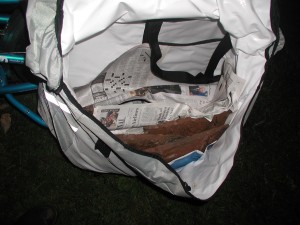 A trick to that is to place the heavier load to the bottom of the bag – the lower the center of mass the bike has, the easier it is to balance it. I felt that clearly: with the 200 pound chicken feed, where two bags had to be placed onto the platform above the wheel, the balancing of the bike was just as hard, than with the heavier evening load, that did fit into the bags, while applying the kickstand was considerably easier with the lighter load.
A trick to that is to place the heavier load to the bottom of the bag – the lower the center of mass the bike has, the easier it is to balance it. I felt that clearly: with the 200 pound chicken feed, where two bags had to be placed onto the platform above the wheel, the balancing of the bike was just as hard, than with the heavier evening load, that did fit into the bags, while applying the kickstand was considerably easier with the lighter load.
Another manageability trick is balance. put equal amount of weight onto each side, otherwise paying attention to riding out of balance is just another challenge you don’t want.
Normally you also want to consider the limit of what the bike and the bike-rack can carry – I luckily didn’t have to pay attention to that, as racking up a 450 pound load involves an insane amount of stuff – except if you get to carry iron pieces as I did this time.

